In Memoriam: Jeff Tinsley
Smithsonian photographer Jeff Tinsley died Dec. 7, 2017 after a long illness. A formal obituary is unavailable, but Jeff’s Smithsonian colleagues are gathered here to share their memories of a dear friend whose career spanned almost 30 years.
UPDATE: A Celebration of Life ceremony will be held Friday, March 9, from 12:00 p.m. to 2:00 p.m. in the Presidential Suite of the National Museum of American History. Please contact Erika Mack at macke@si.edu for more information.
Stephanie Smith
Jeff Tinsley was larger than life—a warm-hearted, gregarious, and talented photographer at the National Museum of American History for twenty-nine years. Jeff first experienced the Smithsonian Folklife Festival in 1976, the year of the Bicentennial. When he got a job as a photographer at the museum a year later, he was thrilled to discover that photographing the Festival would be a part of his job.
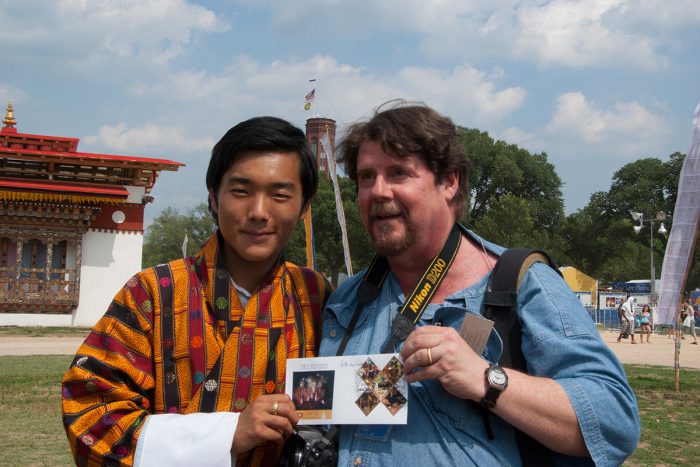
Jeff Tinsley, right, with a participant in the 2000 Folklife Festival featuring Tibetan culture. (Courtesy Ralph Rinzler Folklife Archives)
He photographed the Festival every year until 2005, when he developed a brain tumor and took a disability retirement. He responded extremely well to treatment, causing Jeff to be a sensation with his doctors. Though he was retired, he returned to shoot photos at the 2006 Festival, and each year thereafter until 2012, when his physical stamina in the heat began to wane. The tumor eventually returned and was the cause of his death earlier this month.
I worked with Jeff from the time I arrived at the Smithsonian as an assistant archivist in 1995. He was then the chief photographer at American History, and at that time the museum’s photographers were in charge of documenting whatever was happening on the National Mall—from inaugurations to the Folklife Festival. I first coordinated still photography at the Festival in 1996, working with Jeff and his team as well as interns and volunteers.
In a 2008 interview, Jeff explained some of his approaches for getting the best shots at the Festival. He got to know the staff, allowing him to move around in places that the public couldn’t go, such as on stages and in green rooms. On the Fourth of July, he liked to scout out significant landmarks of the Festival that he could line up with the Washington Monument and the evening fireworks. In 1998, it was the Philippines Chapel, a tent with beautiful decorations. But one of his favorite techniques was to get up high, sometimes on a ladder, a building roof, or on a cherry picker, and sometimes in a U.S. Park Police helicopter.
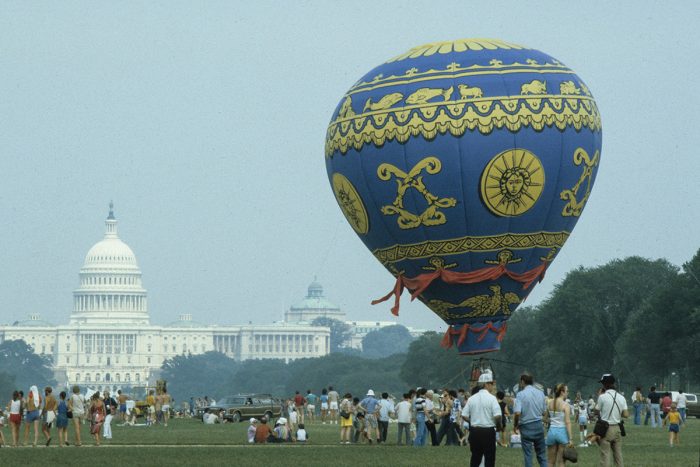
“Aviation,” 1983 Smithsonian Folklife Festival. Photo by Jeff Tinsley, courtesy Ralph Rinzler Folklife Archives
“I’ve always been a person who decided that, to get up and see the whole scope of things was something that was going to be a unique view that none of those people on the ground would ever get,” he said. “I’ve been known to hang out of the side of the helicopter when they took the door off, just put a belt around me and be able to swoop over the crowd, but also just to show the scene of the whole thing.” The shots of the Festival from above are hallmarks of his work and his excellent eye for the unusual perspective.
Aside from the Festival, Jeff developed his skills photographing drag races. He gained a sense of timing, always ready for split-second action, and an ability to switch camera settings manually in a fast-paced environment. With these abilities, he shot many emergent and spontaneous moments at the Festival, capturing the excitement, the colors, textures, and motion on the Mall.
When I asked about his favorite memories of the Festival, Jeff recalled the 2000 Festival when we produced a program called Tibetan Culture Beyond the Land of Snows. “For your whole life to hear about the Dalai Lama who is bigger than life itself, and all of a sudden be sitting or kneeling next to him photographing, and then behind him with the crowd in the background… pretty amazing experience.” The Dalai Lama visited the program site, met the participants, gave a public talk, and performed a Tibetan Buddhist ritual—all of which Jeff captured.
He also recalled attending a 1994 concert in tribute to Ralph Rinzler, co-founder of the Festival, who was ill in a hospital. A tremendous storm hit that evening, with wind and lashing rain. We learned later that Ralph had passed away sometime during the storm. The timing was very eerie, Jeff said, remarking that everyone who worked on the Festival and knew Ralph knows “he’s there with us all the time.”
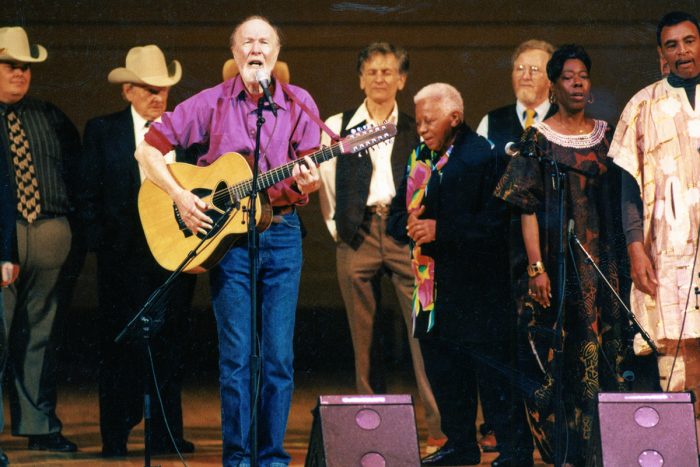
Pete Seeger performs at the Smithsonian Folkways 50th anniversary concert at Carnegie Hall, 1998. Photo by Jeff Tinsley, courtesy Ralph Rinzler Folklife Archives
Some of Jeff’s most stunning photographs are of musicians performing, including Smithsonian Folkways Recordings artists Pete Seeger, Mike Seeger, Arlo Guthrie, Ella Jenkins, John Cephas and Phil Wiggins, BeauSoleil, and others. “If you’re on them, you’re focused in and ready, if you can get them to look at you, it really makes the photo,” he explained. He did some work for Smithsonian Folkways, including a 50th Folkways Anniversary Concert at Carnegie Hall in 1998.
In his final years of documenting the Festival, Jeff struggled with double vision and dizziness resulting from the brain tumor, yet he mostly managed to get his shots despite these challenges. He had to give up flying in the Park Police helicopter, but he was a trouper and called me every year to find out about future programs and what he could look forward to photographing.
Jeff’s photography, particularly of the Festival, has very special qualities, demonstrating his ability to connect with people. His subjects responded to him, and it shows. He would walk around the Festival and, every few feet, would see someone he knew. He was a longtime part of the Folklife family, and he is mourned and missed by us and his photographer colleagues at the Smithsonian.
Jeff was always able to find an engaging, visually appealing composition. His photographs have the ability to tell stories and share knowledge without needing an in-depth description. His photos can stand alone and illustrate the iconic moments, or they can be paired together and present an experience. As he so aptly said, “One of the great things about the Festival is it’s not a one-shot deal. Every hour of every day, there’s some story.”
Jeff’s photographs and his unique personal view tell wonderful stories, and his legacy of the Folklife Festival and significant moments in Smithsonian Folkways history will forever be preserved in our archives. (Originally published by the Center for Folklife and Cultural Heritage on their website.)
Amy Ballard
When I began working at the Smithsonian in 1976, I made many trips to the centralized Smithsonian Office of Printing and Photographic Services to place and pick up many photo orders. James Goode, the Curator of the Smithsonian Castle, wanted to document every repair, event and collection piece in the building, so I spent a lot of time with the photographers and the staff of OPPS.
OPPS was, without a doubt, the most happening place in the Smithsonian. To me, these photographers were the very essence of “cool.” One in particular became a good friend—Jeff Tinsley. One of our adventures occured in the 1990s when Jeff, two of his colleagues and I traveled to New York City to take photographs of the U.S. Custom House, where the American Indian Museum’s George Gustav Heye Center is housed today.
Most of the building was abandoned—the only occupant was the Bankruptcy Court. The four of us spent close to a week taking photographs of the building from top to bottom to document the architectural features and design elements before work began on the Heye Center.
And it wasn’t pretty. We had the company of rats and birds (dead and alive), a lot of dust, fallen builidng material, broken windows and pervasive grimness all around.
Jeff was our team leader and he was unflappable. He had a great sense of humor and was so much fun. It was not an easy week as the building had no air conditioning and was unbearably hot. Despite all this, we got the job done and had a great time doing it.
Jeff was a very modest person. Whenever I would go to OPPS, I’d ask how he was doing, what his next assignment was and he’d just nonchantlanly say “Oh I’m going up in the Park Police helicopter” “I’m photographing Harrison Ford.” “I’m going to take photos of the Supreme Court Justices.” It was all in a day’s work. It was always fun to run into Jeff, with his cameras slung over his shoulders and his good sense of humor and fun.
I retired from the Smithsonian in 2016. Jeff had left several years earlier. As time passed, he was diagnosed with brain cancer. He would attend a few Smithonian events and always brought his camera. While I loved seeing everyone at my retirement party, the person I loved seeing the most was Jeff, who had made a Herculean effort to attend, along with Jeff’s former colleagues at OPPS. It was an amazing surprise and one i will never, ever forget.
Thank you, Jeff, for memories I’ll treasure always and for a job well done.
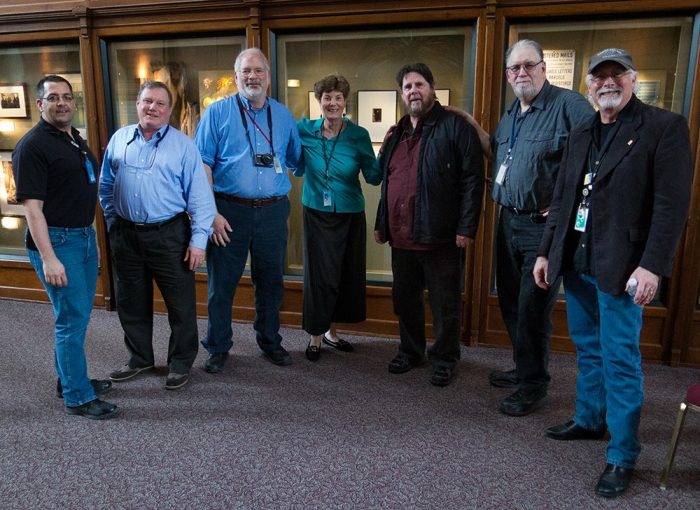
From left, photographers Jim DiLoreto, Richard Strauss, Eric Long, Jeff Tinsley, Hugh Talman and Dane Penland join historian Amy Ballard (center) at her 2016 retirement party.
Eric Long
Jeff Tinsley was to photography what Pete Rose was to baseball. He hustled all the time though his delivery was a bit slower. He was a good friend and a good photographer. Jeff was also responsible for getting my foot in the door at Smithsonian. He was a real people person and I will miss him.
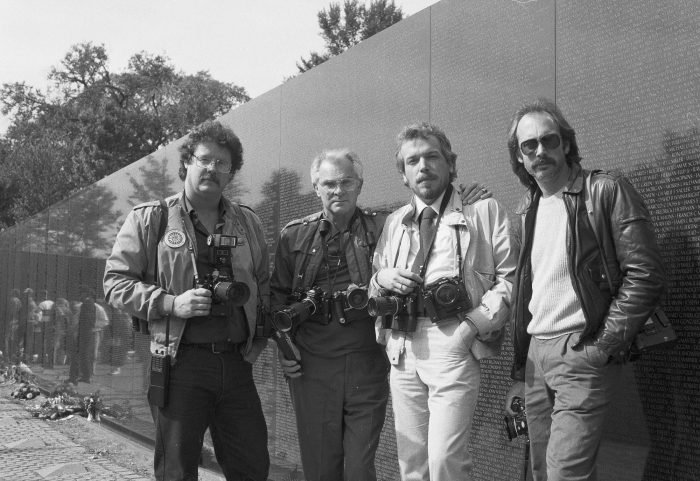
Smithsonian Institution staff photographers, (l-r): Jeff Tinsley, Richard K. Hofmeister, Jeff Ploskonka and Dane Penland, whose work was featured in the SITES exhibition, “Vietnam Veterans Memorial: A National Experience” gather at the wall. Photo by James Wallace, as featured in the Torch, November 1986
William L. Bird
In 2005 Jeff and I spent the better part of an afternoon with Earl Hargrove who was then building parade floats for the Presidential Inauguration. Among the many display props that Hargrove had in his shop was a giant gorilla. Jeff framed this photo and then gave me his camera to take the shot. I’ll always remember him this way.
What a guy.
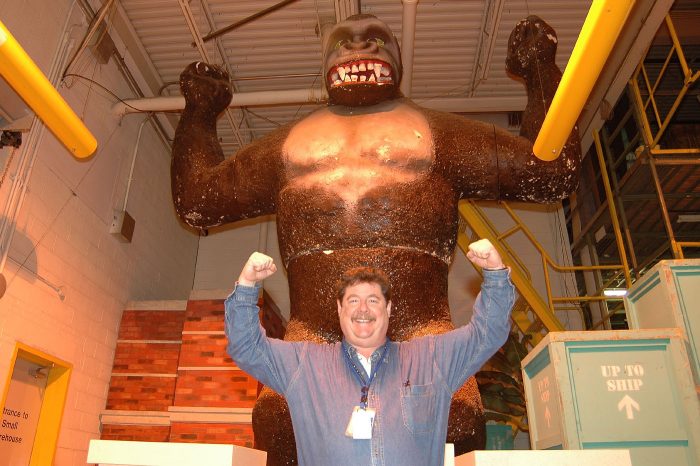
Jeff Tinsley and friend , Presidential Inaugural Float Design & Production at Hargrove, Inc., 2005. Photo courtesy Larry Bird.
Bob Post
For me, it was the before-dawn photo of Swamp Rat 30, with the engine running. It didn’t come out to his satisfaction, so we restaged if after dark. Thirty years ago last October. The photo was turned into a poster which I still have on my wall. Jeff was a peach.
(Ed. The National Museum of American History acquired “Swamp Rat XXX” race car from the National Hot Rod Association in 1987.
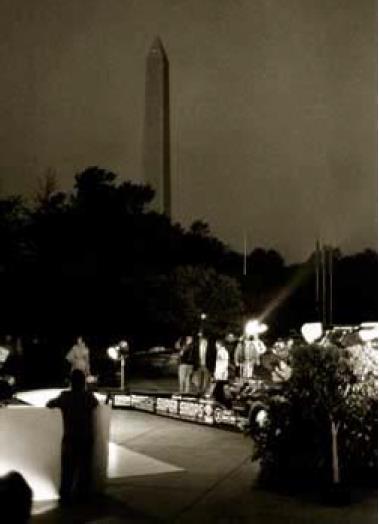
Pre-dawn photo shoot of the Swamp Rat XXX dragster

“Big Daddy” Don Garlits and his Swamp Rat XXX top fuel drag racing car. This was the last time the powerful engine was run before the dragster was donated to the Smithsonian’s National Museum of American History. (Photo by Jeff Tinsley)
Andrea Stevens
In 1964, Jeff & I worked on the spring musical at Walter Johnson High School in Bethesda. He was a dancer, and I was on costume crew for “The Music Man.” When we reconnected a few years later at SI, we joked about our “skinny, theater years” and how we both ended up in creative fields at an academic institution!
These stories about the ways Jeff Tinsley touched so many colleagues in so many parts of the SI make me hope that someone collects & shares them not merely with his family but also with his SI family – perhaps Folklife might take note?
Cheryl Gibney
I spent 28+ years in the central Office of Special Events and Protocol, and coordinated many, many events with Jeff as the photographer for my events. Not only was he my go-to photographer because I knew I could always count on him to be there and get the most important photos, he was also a sweetheart of a guy. Even after his illness and recovery, I saw him numerous times at various events that he came back to SI for so he could be there for someone, always putting others first. And he was always happy to see everyone, with that big smile and great stories of past times together. He will truly be missed, may he rest in peace.
Ginevra Everdale
Jeff was such a kind, unselfish person. I want to emphasize his unselfish sharing of his skills and talents. He was willing to point out other angles, possible shots, other equipment. He was always encouraging. In my experience, few professional photographers are willing to do that (especially non-Smithsonian photographers).
He also had a great eye and skill. I remember a photo he took for an exhibit of grapes that just blew me away. I always enjoyed being at the Festival with him.
The sadness is lightened by so many good memories…I only wish there were even more.
Nicole Krakora
Jeff and I became immediate friends when I joined the SI in 1995 and we worked closely together on events throughout the years. He was a wide open, embracing friend and I’ll always remember him as one of the kindest colleagues I’ve ever known. Whenever I spoke with him recently, he always continued to put others first—turning the conversation away from himself and asking about others. We’ve lost a beautiful soul, but were certainly blessed to have known him.
Posted: 29 January 2018
- Categories:
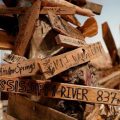





Very nice! The top photo isn’t just a regular Festival participant… it’s Jeff and the Prince of Bhutan! That was in 2008. I remember it well.
Great pic.
Thank you for sharing these beautiful remembrances.
We knew Jeff was a prince, we didn’t realize he hobnobbed with them!
Thanks to all of you for sharing these great tributes to a most wonderful colleague.